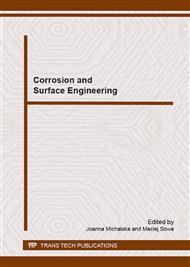p.3
p.7
p.11
p.15
p.19
p.23
p.27
p.31
Corrosion Fatigue Crack Propagation Rates for Steam Turbine Blade 13% Cr Steels
Abstract:
Studies of stress corrosion in X12Cr13 and X20Cr13 steels used for rotor blades of steam turbines have been conducted for determining the average rate of corrosion cracking development da / dt. Specimens were exposed to the salt mist environment of 1,2 ppm NaCl concentration in temperature of 60° C. The research environment represents the initial condensate of humidity from 3÷4%. Average rate of corrosion cracking development for specimens of the X12Cr13 is by 0,005 µm/h higher from specimens of the X20Cr13 steel. Course of the corrosion cracking initiation depends to a high degree on metal structure, and probably the close value of cracking propagation rate depends on the similar structure of those steels – high-tempered martensite with carbides at grain boundaries.
Info:
Periodical:
Pages:
7-10
Citation:
Online since:
January 2015
Authors:
Keywords:
Price:
Сopyright:
© 2015 Trans Tech Publications Ltd. All Rights Reserved
Share:
Citation:


